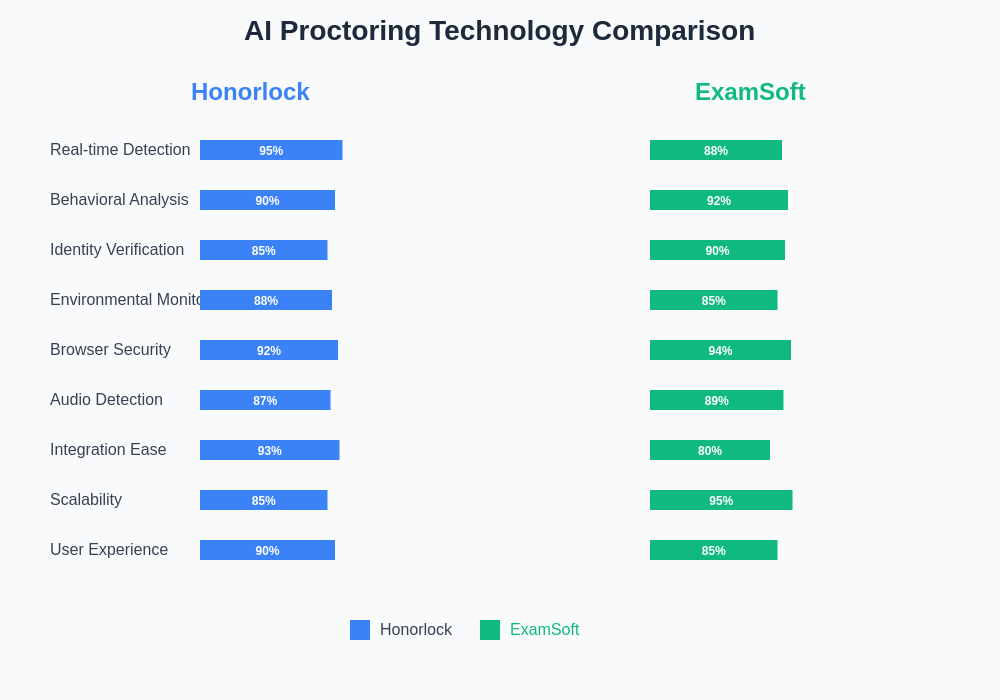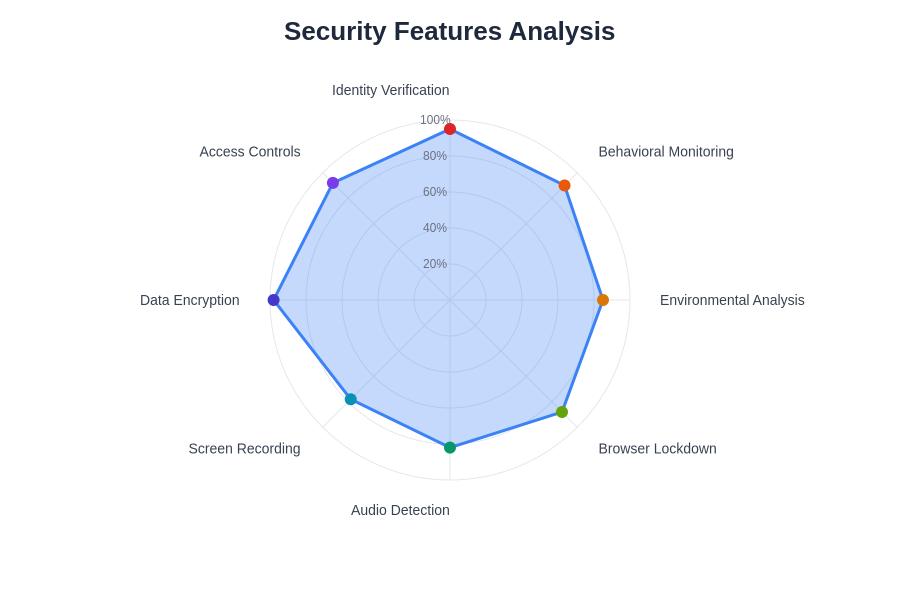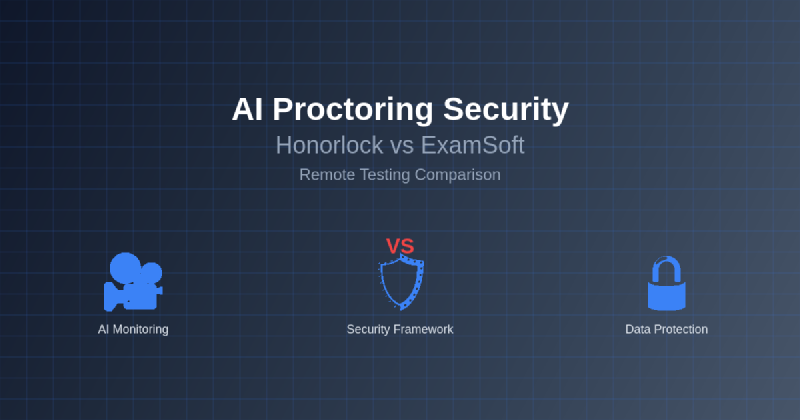The landscape of educational assessment has been revolutionized by artificial intelligence-powered proctoring solutions, with remote testing becoming an essential component of modern academic and professional certification programs. As institutions increasingly rely on digital assessment platforms, the choice between sophisticated AI proctoring systems like Honorlock and ExamSoft has become critical for maintaining academic integrity while ensuring accessibility and user experience in remote testing environments.
Explore the latest AI innovations in educational technology to understand how machine learning is transforming assessment methodologies across various educational sectors. The integration of AI proctoring represents a fundamental shift from traditional supervision methods to intelligent monitoring systems that can detect and prevent academic dishonesty through advanced behavioral analysis and environmental monitoring technologies.
The Evolution of AI-Powered Remote Proctoring
The traditional model of in-person exam supervision has been fundamentally transformed by the emergence of AI-powered proctoring solutions that leverage computer vision, natural language processing, and behavioral analytics to maintain exam integrity in remote environments. These sophisticated systems represent a convergence of multiple technological disciplines, creating comprehensive monitoring ecosystems that can simultaneously track eye movements, analyze audio patterns, monitor browser activity, and detect environmental irregularities that might indicate cheating attempts.
The development of AI proctoring technology has been accelerated by the global shift toward remote learning and assessment, driven initially by necessity but now recognized as a permanent component of educational delivery systems. Modern AI proctoring platforms employ machine learning algorithms trained on vast datasets of exam behaviors, enabling them to distinguish between normal test-taking activities and suspicious actions that warrant human review or immediate intervention.
The sophistication of these systems extends beyond simple rule-based monitoring to include predictive analytics that can identify potential integrity violations before they occur, creating proactive security measures that enhance the overall reliability of remote assessment programs. This evolution has created new standards for educational technology that prioritize both security and user experience while maintaining the academic rigor necessary for credible certification and degree programs.
Honorlock’s AI-Driven Security Framework
Honorlock has positioned itself as a leader in AI-powered proctoring through its comprehensive security framework that combines multiple layers of technological monitoring with human oversight capabilities. The platform’s core strength lies in its ability to integrate seamlessly with existing learning management systems while providing sophisticated real-time monitoring that adapts to individual test-taking behaviors and environmental conditions.
The system’s AI engine continuously analyzes video feeds from test-takers’ devices, employing computer vision algorithms to detect unauthorized materials, suspicious eye movements, and environmental changes that might indicate the presence of unauthorized assistance. Honorlock’s approach to facial recognition and identity verification ensures that the registered student is the individual taking the exam, while its advanced audio monitoring capabilities can detect conversations, unusual background noise, and other audio anomalies that might suggest cheating attempts.
Discover advanced AI capabilities with Claude for understanding complex machine learning implementations in educational security systems. Honorlock’s integration of natural language processing enables the system to analyze spoken words during exams, identifying keywords or phrases that might indicate academic dishonesty while maintaining privacy through selective processing that focuses only on potential security threats.
The platform’s adaptive learning capabilities allow it to continuously improve its detection accuracy by analyzing patterns across thousands of exam sessions, creating increasingly sophisticated models that can distinguish between legitimate test-taking behaviors and potential integrity violations. This machine learning approach reduces false positives while enhancing the system’s ability to identify subtle forms of cheating that traditional monitoring methods might miss.
Honorlock’s commitment to user experience is evident in its streamlined setup process and minimal technical requirements, making it accessible to students with varying levels of technical expertise while maintaining robust security standards. The platform’s browser lockdown capabilities prevent access to unauthorized websites and applications during exams, while its screen recording functionality provides comprehensive documentation for post-exam review if integrity concerns arise.
ExamSoft’s Comprehensive Assessment Security Platform
ExamSoft has established itself as a dominant force in secure assessment delivery through its comprehensive platform that combines AI-powered monitoring with advanced psychometric analysis and robust data security measures. The system’s architecture is designed to support large-scale assessment programs while providing granular control over exam conditions and security parameters that can be customized for different types of evaluations and institutional requirements.
The platform’s AI monitoring capabilities encompass multiple dimensions of test-taking behavior, including keystroke dynamics analysis that can detect unusual typing patterns suggesting unauthorized assistance or the use of external resources. ExamSoft’s computer vision algorithms monitor test-takers through webcam feeds, analyzing facial expressions, eye movements, and body language to identify behaviors consistent with cheating attempts while maintaining sensitivity to individual differences in test-taking styles.
ExamSoft’s approach to environmental monitoring extends beyond the immediate testing area to include analysis of lighting conditions, background movements, and audio patterns that might indicate the presence of unauthorized individuals or resources. The system’s machine learning models have been trained on extensive datasets that enable accurate detection of various cheating methodologies while minimizing disruptions to legitimate test-takers who exhibit normal anxiety or movement patterns during high-stakes examinations.
The platform’s integration capabilities with institutional systems allow for seamless data flow between assessment platforms, learning management systems, and academic records databases, creating a comprehensive ecosystem for secure assessment delivery and results management. ExamSoft’s commitment to data security includes end-to-end encryption, secure cloud storage, and compliance with educational privacy regulations that protect student information while enabling effective monitoring and analysis.
Comparative Analysis of AI Detection Capabilities
The fundamental difference between Honorlock and ExamSoft lies in their approach to AI-powered detection and the sophistication of their machine learning algorithms. Honorlock emphasizes real-time detection and immediate intervention capabilities, employing AI models that can identify suspicious behaviors within seconds of their occurrence and either alert human proctors or automatically flag sessions for review based on predetermined security thresholds.
ExamSoft’s detection framework focuses on comprehensive behavioral analysis that considers multiple data points across the entire exam session, using sophisticated pattern recognition algorithms to identify subtle indicators of academic dishonesty that might not be immediately apparent but become significant when analyzed in aggregate. This approach allows for more nuanced detection of collaborative cheating attempts and sophisticated technological circumvention methods that single-point detection systems might miss.
Enhance your research capabilities with Perplexity for comprehensive analysis of AI proctoring effectiveness and implementation strategies across different educational contexts. The machine learning models employed by both platforms continue to evolve through exposure to new cheating methodologies and testing scenarios, creating adaptive security systems that can respond to emerging threats while maintaining low false positive rates that preserve the testing experience for honest students.
The accuracy of AI detection systems depends heavily on the quality and diversity of training data used to develop machine learning models, and both Honorlock and ExamSoft have invested significantly in building comprehensive datasets that represent various demographic groups, testing environments, and academic disciplines. This commitment to inclusive AI development ensures that detection algorithms perform consistently across different student populations while avoiding bias that could disproportionately affect certain groups.
Security Infrastructure and Data Protection
The security infrastructure underlying AI proctoring platforms represents a critical consideration for institutions evaluating these solutions, as the systems must protect not only exam content but also sensitive biometric and behavioral data collected during monitoring processes. Honorlock’s security framework employs multiple layers of encryption and access controls to protect data transmission and storage, while implementing strict protocols for data retention and deletion that comply with educational privacy regulations.
ExamSoft’s approach to data security encompasses comprehensive encryption protocols, secure cloud infrastructure, and rigorous access controls that ensure only authorized personnel can access monitoring data and exam recordings. The platform’s compliance with international data protection standards provides institutional clients with confidence that student privacy is maintained while enabling effective security monitoring and post-exam analysis capabilities.
Both platforms implement sophisticated authentication mechanisms that verify student identities through multiple factors, including biometric analysis, knowledge-based authentication, and device fingerprinting that creates unique digital signatures for each test-taking session. These multi-layered authentication approaches significantly reduce the possibility of proxy test-taking while maintaining user-friendly access procedures that minimize barriers to legitimate students.
The data analytics capabilities of both platforms extend beyond immediate security monitoring to include comprehensive reporting and analysis tools that help institutions understand testing patterns, identify systemic integrity issues, and optimize their assessment security strategies. These analytical insights enable continuous improvement of security measures while providing evidence-based support for academic integrity policies and procedures.
Implementation Strategies and Institutional Integration
The successful implementation of AI proctoring solutions requires careful consideration of institutional infrastructure, technical requirements, and user training programs that ensure effective adoption while maintaining security effectiveness. Honorlock’s implementation approach emphasizes rapid deployment with minimal technical requirements, allowing institutions to begin using the platform quickly while gradually expanding security features and customization options based on specific needs and experience.
ExamSoft’s implementation methodology focuses on comprehensive integration with existing institutional systems and processes, requiring more extensive planning and configuration but providing deeper integration with academic workflows and administrative systems. This approach enables more sophisticated reporting and analytics capabilities while ensuring that proctoring data integrates seamlessly with other academic technology platforms and student information systems.
Both platforms provide extensive training and support resources for administrators, faculty, and students, recognizing that user adoption and comfort with the technology directly impacts security effectiveness and overall assessment success. The training programs cover not only technical operation of the platforms but also best practices for exam design, security policy development, and incident response procedures that maximize the effectiveness of AI proctoring capabilities.
The scalability considerations for both platforms address the need to support varying numbers of concurrent users, different types of assessments, and diverse institutional requirements while maintaining consistent security standards and user experiences. This scalability is particularly important for institutions that conduct large-scale assessments or experience significant fluctuations in testing volume throughout academic cycles.
Cost Analysis and Return on Investment
The financial considerations associated with AI proctoring implementation extend beyond simple licensing costs to include infrastructure requirements, training expenses, and ongoing support needs that vary significantly between different platforms and institutional contexts. Honorlock’s pricing model typically emphasizes per-use fees that allow institutions to scale costs with actual usage while minimizing upfront investment requirements, making it attractive for institutions with variable testing volumes or limited budgets for educational technology initiatives.
ExamSoft’s cost structure often involves more comprehensive licensing arrangements that include platform access, support services, and advanced analytics capabilities, providing predictable costs for institutions with consistent assessment needs while offering enhanced functionality and integration capabilities that justify higher investment levels for organizations requiring sophisticated assessment management capabilities.
The return on investment calculations for AI proctoring platforms must consider both direct cost savings from reduced need for human proctors and indirect benefits such as improved academic integrity, enhanced institutional reputation, and increased flexibility in assessment delivery that can attract students and improve educational outcomes. These broader benefits often justify the technology investment even when direct cost comparisons might favor traditional proctoring methods.
Long-term cost considerations include platform evolution, feature updates, and changing regulatory requirements that may necessitate additional investment or platform modifications over time. Both Honorlock and ExamSoft have demonstrated commitment to continuous platform development and regulatory compliance, providing institutional clients with confidence that their investment will remain viable and effective as technology and educational standards evolve.
Privacy Considerations and Regulatory Compliance
The privacy implications of AI proctoring technology require careful consideration of student rights, data protection regulations, and institutional policies that govern the collection, use, and retention of biometric and behavioral monitoring data. Honorlock’s privacy framework addresses these concerns through transparent data collection policies, limited retention periods, and student consent mechanisms that ensure compliance with educational privacy laws while maintaining security effectiveness.
ExamSoft’s approach to privacy protection includes comprehensive data governance policies, student rights notifications, and technical safeguards that protect sensitive information while enabling effective monitoring and analysis capabilities. The platform’s compliance with international privacy standards provides institutions with confidence that their implementation meets regulatory requirements across different jurisdictions and educational contexts.
Both platforms must navigate the complex balance between effective security monitoring and student privacy protection, implementing technical and policy measures that enable detection of academic dishonesty while minimizing intrusion on legitimate test-taking activities and protecting sensitive personal information from unauthorized access or misuse.
The evolving regulatory landscape for AI applications in education requires ongoing attention to compliance requirements and privacy standards that may change as governments and educational authorities develop new frameworks for artificial intelligence use in academic settings. Both platforms demonstrate commitment to regulatory compliance through active engagement with policymakers and educational organizations to ensure their technology meets current and anticipated privacy protection standards.
User Experience and Accessibility Considerations
The user experience design of AI proctoring platforms significantly impacts student performance, anxiety levels, and overall assessment effectiveness, requiring careful balance between security requirements and user-friendly interfaces that minimize technical barriers and stress-inducing elements. Honorlock’s user interface emphasizes simplicity and clarity, providing clear instructions and minimal setup requirements that reduce technical anxiety while maintaining comprehensive security monitoring capabilities.
ExamSoft’s user experience framework addresses the needs of diverse student populations through accessibility features, multilingual support, and accommodations for students with disabilities that ensure equitable access to secure assessment opportunities while maintaining security standards. The platform’s attention to inclusive design principles demonstrates commitment to educational equity while providing robust security monitoring capabilities.
Both platforms recognize that student anxiety and technical difficulties can negatively impact exam performance and potentially trigger false positive security alerts, requiring sophisticated AI algorithms that can distinguish between stress-related behaviors and actual cheating attempts while providing user interfaces that minimize unnecessary stress and confusion during high-stakes assessments.
The accessibility considerations for AI proctoring platforms must address diverse student needs including visual, auditory, and motor impairments that may affect interaction with monitoring technology or trigger false security alerts. Both platforms provide accommodation options and alternative monitoring approaches that maintain security effectiveness while ensuring equitable access for all students regardless of their technical capabilities or physical limitations.
Future Developments and Technology Evolution
The trajectory of AI proctoring technology development indicates continued advancement in machine learning capabilities, biometric analysis, and behavioral detection that will enhance security effectiveness while improving user experiences and reducing false positive rates. Honorlock’s research and development initiatives focus on emerging technologies such as advanced eye-tracking analysis, improved natural language processing, and enhanced environmental monitoring that will provide more sophisticated detection capabilities with minimal user impact.
ExamSoft’s technology roadmap emphasizes integration with emerging educational technologies, enhanced psychometric analysis capabilities, and improved artificial intelligence models that can provide more nuanced understanding of test-taking behaviors while maintaining strong security standards and regulatory compliance. The platform’s commitment to innovation ensures that institutional clients will benefit from continued technology advancement without requiring frequent platform migrations or major implementation changes.
The convergence of AI proctoring with other educational technologies such as adaptive assessment platforms, learning analytics systems, and virtual reality environments will create new opportunities for secure assessment delivery while presenting new challenges for security monitoring and integrity maintenance. Both platforms are positioning themselves to integrate with these emerging technologies while maintaining their core competencies in secure assessment delivery and AI-powered monitoring.
The future landscape of AI proctoring will likely include enhanced personalization capabilities that adapt monitoring parameters to individual student needs and behaviors, creating more effective security measures while improving user experiences and reducing the stress associated with remote assessment environments. This evolution toward personalized proctoring represents the next phase of AI development in educational technology, promising more effective and user-friendly security solutions for remote assessment programs.

The comparative analysis of AI proctoring technologies reveals significant differences in approach, capability, and implementation requirements that institutions must carefully consider when selecting platforms for their remote assessment programs. Understanding these technological distinctions enables informed decision-making that aligns security needs with institutional resources and educational objectives.

The comprehensive evaluation of security features demonstrates the multi-layered approach required for effective AI proctoring, highlighting the importance of combining technological monitoring with policy frameworks and user education to create robust academic integrity programs that protect the value of educational credentials while maintaining accessibility and fairness for all students.
Disclaimer
This article is for informational purposes only and does not constitute professional advice regarding the selection or implementation of AI proctoring solutions. The views expressed are based on publicly available information and general industry analysis. Educational institutions should conduct their own thorough evaluation of proctoring platforms, including security assessments, privacy impact analyses, and pilot testing programs before making implementation decisions. The effectiveness and appropriateness of AI proctoring solutions may vary depending on specific institutional needs, student populations, regulatory requirements, and assessment contexts. Readers should consult with educational technology specialists, legal advisors, and privacy professionals when evaluating and implementing AI proctoring systems.
